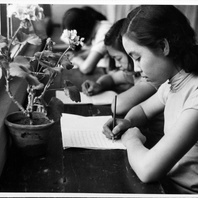
Page
Essays
In this section, users can read short essays by members of the COTCA Team about specific images or collections which are included in the COTCA Digital Archive. Some essays are also built around general events, people, or institutions which correspond with specific themes, items or events appearing in the case studies.
Read More
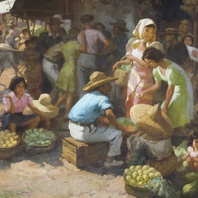
Person
L. Odila Schroeder
Read More
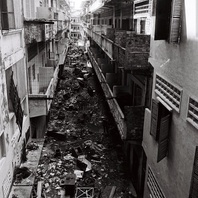
Featured Item
Empty alleyway, Phnom Penh
This picture shows a small, empty alleyway littered with rubble in Phnom Penh. It was probably taken in the days following the city’s takeover in January 1979. This photograph is part of the collection held by the Agence Khmère de Presse (AKP) and Cambodia’s Ministry of Information. This collection, which documents the early years of the People’s Republic of Kampuchea as photographed by the Vietnamese and a small team of Cambodian photographers, has not yet been classified or indexed.
Read More
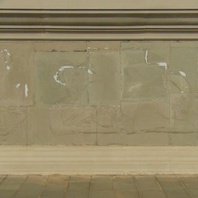
Item
Win-Win Monument base
This photograph shows an empty section of the 117-metre-long engraved base of the Win-Win Monument, with traces that show some work has been done and subsequently removed. The Win-Win Monument complex – photographed here in January 2020 – was inaugurated in December 2018 to mark the twentieth anniversary of the end of the post-Democratic Kampuchea civil war, with the final defection of the remaining Khmer Rouge factions, thanks to the DIFID policy (“Divide, Isolate, Finish, Integrate, Develop”) also known as the “Win Win” policy of Prime Minister Hun Sen.
Read More
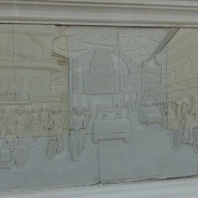
Item
Win-Win Monument bas-relief
View of bas-relief on the 117-metre-long engraved base of the Win-Win Monument. It depicts a busy street scene around the Central Market in pre-1970 Phnom Penh. The Win-Win Monument complex – photographed here in January 2020 – was inaugurated in December 2018 to mark the twentieth anniversary of the end of the post-Democratic Kampuchea civil war, with the final defection of the remaining Khmer Rouge factions, thanks to the DIFID policy (“Divide, Isolate, Finish, Integrate, Develop”) also known as the “Win Win” policy of Prime Minister Hun Sen.
Read More
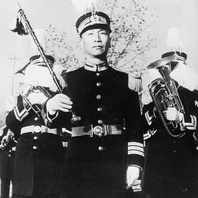
Item
Drum major
Photograph of an RNG brass band led by a drum major in front of the Executive Yuan in Japanese-occupied Nanjing. The “occupation state” put great store in military parades.
Read More
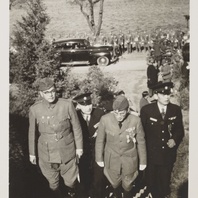
Item
Subhas Chandra Bose in Nanjing, November 1943
Lin Baisheng, RNG publicity minister (second from right) and Chu Minyi (second from left) accompany a uniformed Subhas Chandra Bose (far left) (leader of the Indian National Army) during his visit to Nanjing in November 1943. Both Wang Jingwei and Bose had attended the Greater East Asia Conference in Tokyo in the same month, and Bose’s visit to Nanjing was celebrated by an administration which had few opportunities to welcome prominent international leaders to its capital.
Read More
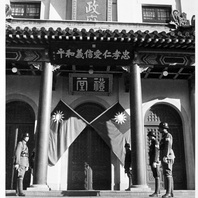
Item
Entrance to RNG Government Headquarters
Chinese and Japanese soldiers guard the entrance to the ceremonial hall (litang) of the national government compound in Nanjing in November 1940. Above the door is a plaque, written by the head of the (non-RNG) national government Lin Sen, which reads: “Loyalty, benevolence, righteousness and peace” (zhongxiao, ren’ai. xinyi, heping). Note that the “unadulterated” Nationalist Chinese flag (without the yellow pennant that the RNG had been forced to attach by the Japanese in spring 1940) is flown here.
Read More
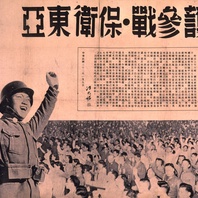
Item
Yonghu canzhan, baowei Dong Ya (Support the declaration of war; defend East Asia)
Poster of Chinese soldier celebrating the declaration of war on the Allies by RNG China. The poster reads “Yonghu canzhan, baowei Dong Ya” (Support the declaration of war; defend East Asia), and includes the text of Wang Jingwei’s declaration of war on the Allies on 9 January 1943. Note that some postwar owner of this poster has written “wei guomin zhengfu” (bogus National Government) to the right of the text by Wang Jingwei so as to clarify which Chinese administration was declaring war on this occasion.
Read More
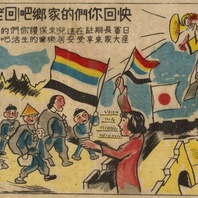
Item
Kuai hui nimen de jiaxiang ba! (Hurry back to your homes!)
This leaflet, produced with the aim of encouraging civilians in occupied north China to return to cities and towns under Japanese rule, includes many of the standard tropes of early occupied north China propaganda: a “new woman”; city walls; the “five-coloured flag” (wuseqi). The text on the leaflet reads: “Hurry back to your homes! Return to your hometowns! The Japanese army will be here for a long time. Come and protect your livelihoods and your assets. Everyone can savour living in peace and enjoying their work again”.
Read More
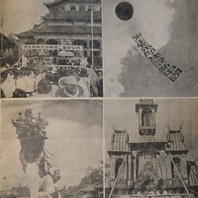
Item
Celebratory ceremony marking the second anniversary of Guangdong’s ‘rebirth’
This series of photographs is taken from Huanan huabao (South China graphic) 2.6 (1940), and shows celebrations to mark the second anniversary of what the Japanese referred to as the “rebirth” of Guangzhou (i.e., the fall of Guangzhou) in October 1938. Note the prominence given to the Sun Yat-sen Memorial Hall, as well as the use of “folk” forms of cultural expression.